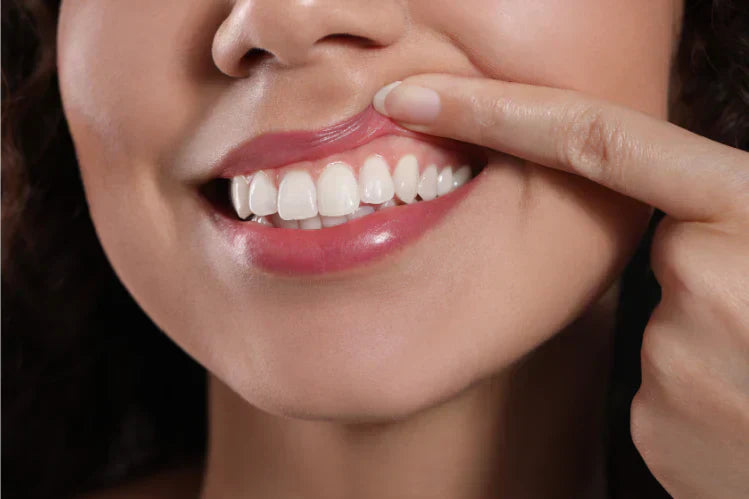
Table des matières
- Gencives fines ou gencives épaisses : pourquoi c'est important
- Comment le redressement des dents affecte vos gencives
- Appareils dentaires et vos gencives
- Aligneurs transparents : une option plus douce pour vos gencives
- Maintenir des gencives saines pendant le redressement des dents
- Maladies des gencives courantes et leur impact sur le redressement des dents
- Réflexions finales
- FAQ
Lorsqu'on pense à redresser ses dents, on pense généralement aux appareils dentaires ou aux aligneurs transparents. Mais Il y a un autre élément important de l'équation, souvent négligé… vos gencives ! Elles fournissent des nutriments essentiels. Le soutien de vos dents et leur épaisseur peuvent influencer l'efficacité de votre traitement. Que vos gencives soient épaisses ou mince, comprendre leur rôle dans le processus peut vous aider à mieux prendre soin de votre sourire et à obtenir le meilleur résultat possible résultats de votre traitement orthodontique.
Gencives fines ou gencives épaisses : pourquoi c'est important
Les gencives ont des épaisseurs différentes, ce qui peut affecter à la fois votre santé bucco-dentaire et le succès de vos dents. traitement de lissage.
- Gencives épaisses : Les personnes ayant des gencives épaisses ont des tissus plus solides qui soutiennent bien leurs dents. Cependant, des gencives épaisses peuvent parfois recouvrir une trop grande partie des dents, ce qui peut nécessiter un remodelage. pour créer un look plus équilibré.
- Gencives fines : celles qui ont Les gencives fines présentent un risque accru de récession gingivale, notamment lors d'un traitement orthodontique. s'irritent facilement, il faut donc faire très attention pour les garder en bonne santé.
Comment le redressement des dents affecte vos gencives
Les appareils dentaires et les aligneurs transparents déplacent progressivement vos dents vers leur emplacement. Ce mouvement affecte également vos gencives. et les résultats peuvent varier en fonction de votre type de gencives :
- Le mouvement des dents peut provoquer une légère gonflement au début, mais les gencives épaisses sont fortes et s'ajustent généralement Bien.
- Les gencives fines sont plus sensibles, donc le déplacement des dents peut entraîner une récession des gencives, ce qui rend encore plus important le maintien d'une bonne santé bucco-dentaire. hygiène et visites dentaires régulières.
Appareils dentaires et vos gencives
Les appareils orthodontiques fonctionnent en appliquant une pression sur vos dents pour les déplacer vers la position souhaitée, mais cette pression et Le mouvement n'affecte pas seulement les dents, il affecte aussi les gencives. Si vos gencives sont plutôt fines, un appareil dentaire peut parfois être nécessaire. entraîner une récession gingivale. Les brackets et fils métalliques peuvent également rendre le brossage et l'utilisation du fil dentaire plus difficiles, ce qui peut entraîner Gencives gonflées ou enflammées. Si vous vous êtes déjà demandé si les appareils dentaires pouvaient causer des problèmes de gencives, la réponse est oui. Voilà pourquoi. il est important de parler à votre dentiste de la santé de vos gencives avant de commencer le traitement.

Aligneurs transparents : une option plus douce pour vos gencives
Les aligneurs transparents, comme ceux d'ALIGNERCO, sont conçus pour être lisses et sans irritation. Contrairement aux appareils orthodontiques, qui ont des fils et des supports qui peuvent frotter contre vos gencives, les aligneurs sont fabriqués à partir de plastique souple sans BPA qui s'adapte parfaitement à vos dents. Cela signifie moins d'irritation et un risque moindre d'inflammation des gencives. De plus, comme les aligneurs Comme elles sont amovibles, vous pouvez facilement maintenir une bonne hygiène bucco-dentaire et réduire ainsi le risque de maladies et de récessions gingivales . Si vous avez des gencives sensibles ou si vous vous inquiétez de la récession des gencives, les aligneurs transparents pourraient être le choix idéal pour vous.
Maintenir des gencives saines pendant le redressement des dents
Quel que soit le type de gencives que vous avez, il y a quelque chose que vous pouvez faire pour maintenir leur santé :
- Faites du brossage et de l'utilisation du fil dentaire une routine quotidienne Habitude : Maintenir une routine d'hygiène bucco-dentaire cohérente en se brossant soigneusement les dents et en utilisant du fil dentaire chaque jour est essentiel pour garder vos gencives propres et exemptes de bactéries nocives. Des gencives saines et propres sont bien moins sensible à l’inflammation et à d’autres problèmes potentiels pouvant survenir en cas de négligence.
- Optez pour une brosse à poils doux Brosse à dents : Choisir une brosse à dents à poils souples est un choix judicieux, car elle offre un nettoyage plus doux. action nettoyante qui minimise l'irritation et l'abrasion. Ceci est particulièrement important pour les personnes aux cheveux fins. ou des gencives sensibles, car un brossage trop agressif peut entraîner des dommages et un inconfort inutiles.
- Planifier des soins dentaires réguliers Examens de contrôle : Consulter votre dentiste pour des examens de routine permet à un professionnel de surveiller de près l'état de vos gencives et identifier les premiers signes de problèmes. Suite à leur évaluation, ils pourront vous recommander des traitements personnalisés ou des mesures préventives pour assurer que la santé de vos gencives reste optimale.
- Maintenir un équilibre Régime alimentaire : Consommer une variété d’aliments nutritifs riches en vitamines et minéraux joue un rôle crucial dans fortifie vos gencives et favorise une bonne santé bucco-dentaire. Une alimentation saine favorise des gencives fortes et aide votre le corps résiste aux infections et autres problèmes dentaires.

Maladies courantes des gencives et leur impact sur les dents Lissage
La santé de vos gencives est essentielle pour redresser vos dents. Voici quelques maladies courantes des gencives qui peuvent affecter votre santé. processus:
Gingivite : Il s'agit du stade le plus précoce de la maladie des gencives, où les gencives deviennent rouges, enflées et peuvent Saignement lors du brossage. En l'absence de traitement, ce problème peut évoluer vers des affections plus graves, rendant le traitement orthodontique plus complexe. stimulant.
Parodontite : stade plus avancé de la maladie des gencives où les gencives se détachent des dents, formation de poches pouvant entraîner la perte des dents. Si vous souffrez de parodontite , un traitement des gencives peut être nécessaire avant de commencer à porter des aligneurs ou un appareil dentaire.
Récession gingivale : cela se produit lorsque le tissu gingival s'use, exposant les racines de vos dents. Les gencives fines sont plus sujettes à ce problème, et les appareils orthodontiques peuvent parfois aggraver le problème. Les aligneurs transparents, plus doux, peuvent être une meilleure option pour les personnes ayant des gencives rétractées.
Réflexions finales
Des gencives saines sont tout aussi importantes que des dents droites pour un beau sourire. Savoir si vos gencives sont épaisses ou minces peuvent vous aider à prendre les bonnes mesures pour les maintenir en bon état pendant votre traitement orthodontique. Avec un traitement approprié soins, vous pouvez profiter d'un voyage fluide et réussi vers un meilleur sourire.
FAQ
1. Le chewing-gum épais est-il meilleur que le chewing-gum fin ?
Les gencives épaisses offrent une meilleure protection contre la récession, tandis que les gencives fines sont plus sujettes à la sensibilité et à l’irritation.
2. Des gencives fines peuvent-elles redevenir épaisses ?
Des gencives fines peuvent-elles redevenir épaisses ? Pas naturellement, mais la greffe de gencive ou d’autres traitements dentaires peuvent aider à améliorer l’épaisseur des gencives.
3. Que signifie avoir des gencives épaisses ?
Les gencives épaisses offrent un soutien solide aux dents, mais un excès de tissu gingival peut parfois conduire à un « sourire gingival » ou nécessiter un contournage pour des raisons esthétiques.
4. Peut-on porter un appareil dentaire avec des gencives fines ?
Oui, mais une attention particulière est nécessaire pour prévenir la récession gingivale. Les aligneurs transparents peuvent être une option plus douce pour les personnes ayant des gencives fines.
5. Pourquoi mes gencives sont-elles si épaisses ?
L'épaisseur des gencives est génétique. Cependant, dans certains cas, des gencives très épaisses peuvent indiquer un problème sous-jacent et nécessitent une consultation chez le dentiste.
6. Comment obtenir des gencives épaisses ?
Si vous êtes né avec des gencives fines et que vous souffrez de récession gingivale, la greffe de gencive, la chirurgie par lambeau et le traitement au laser sont des solutions possibles. Cependant, consultez votre orthodontiste avant toute intervention.
Références
« Par Gum ! Pourquoi la santé des gencives est importante. » Cleveland Clinic , my.clevelandclinic.org/health/body/24972-gums.
Kao, Richard T, et Kirk Pasquinelli. « Tissu gingival épais ou mince : un déterminant clé de la réponse tissulaire à la maladie et au traitement restaurateur. » Journal of the California Dental Association, vol. 30, n° 7, juillet 2002, p. 521–6, pubmed.ncbi.nlm.nih.gov/12216915/ .






